For the past weeks, the water level in Angat Dam, which supplies 97% of Metro Manila’s water needs, has been slowly but continuously decreasing. According to the Climate Outlook Forum of the Philippine Atmospheric, Geophysical and Astronomical Services Administration (PAGASA) last September 23, the dam’s level was at 177.3 meters, 32.67 meters less than its normal water level of 210 meters.
But according to Rosalie Pagulayan of the Hydro-Meteorological Division of PAGASA, historical data in the past 14 years shows that Angat Dam’s water level typically dips during this time.
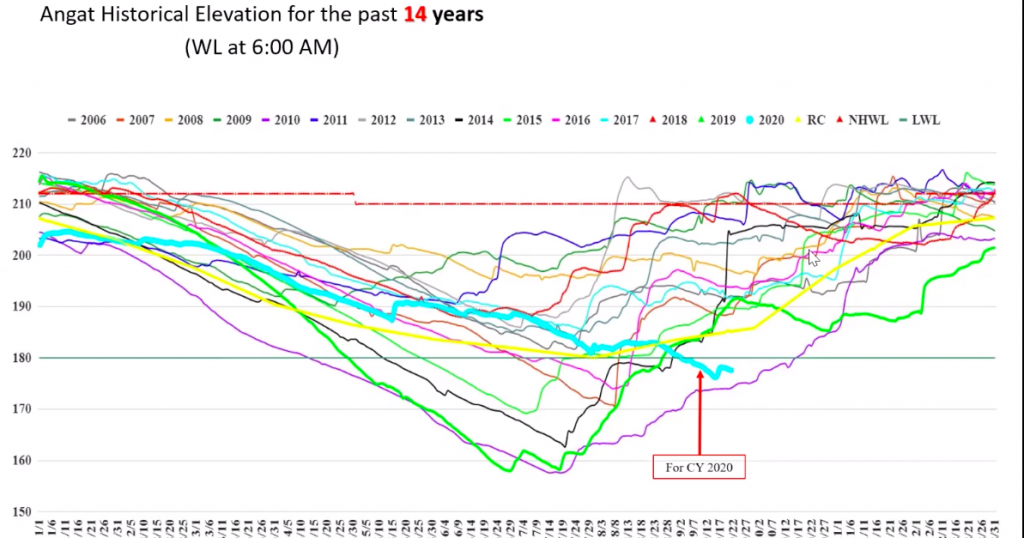 Angat Dam’s current downward trend in light blue (graph from PAGASA)
Angat Dam’s current downward trend in light blue (graph from PAGASA)
“Its level continues to decrease, but we expect it to increase during the Northeast Monsoon. Even with no typhoons, we can expect Angat Dam to recover in the last quarter of the year,” says Pagulayan. This is based on the forecast rainfall of PAGASA’s Climatology and Agrometeorology Division, which shows an expected 386 millimeters in October, 294 millimeters in November and 129.5 millimeters in December.
Forecast Rainfall for the remainder of 2020
| October | 386 millimeters |
| November | 295 millimeters |
| December | 129.5 millimeters |
Metro Manila’s Main Water Source
The Angat Reservoir and Dam is located in the Angat Watershed Forest Reserve in Norzagaray, Bulacan. According to Manila Water, the dam supplies the water requirements of Metro Manila, and irrigates about 31,000 hectares of farmlands in Pampanga and Bulacan. It also generates hydroelectric power for the Luzon Grid, and holds water to reduce flooding in downstream towns and villages.
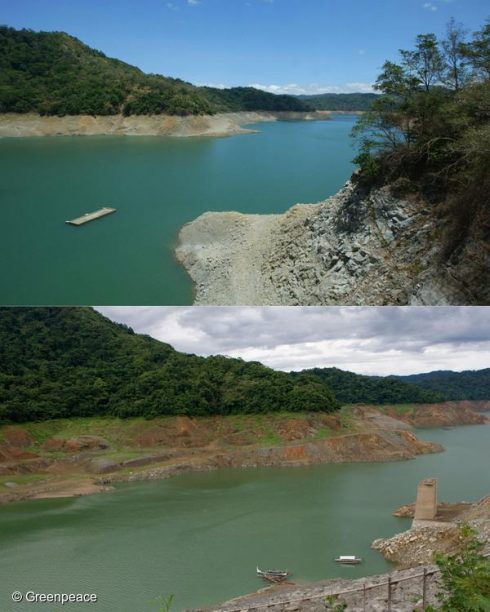 Top photo of Angat Dam taken last April 13, 2010 when water levels hit the critical 180 meters above sea level. Photo at the bottom with the structure completely exposed, was taken last July 16, 201, when levels reached a historical low of 157.55 meters. (Top photo by Joseph Agcaoili /Greenpeace. Bottom photo by Gigie Cruz-Sy /Greenpeace)
Top photo of Angat Dam taken last April 13, 2010 when water levels hit the critical 180 meters above sea level. Photo at the bottom with the structure completely exposed, was taken last July 16, 201, when levels reached a historical low of 157.55 meters. (Top photo by Joseph Agcaoili /Greenpeace. Bottom photo by Gigie Cruz-Sy /Greenpeace)
The dam usually stores enough water for Metro Manila’s 30-day supply. But El Niño, which refers to the unusual warming the oceans giving way to higher temperatures, can affect dam levels. On July 18, 2010, Angat Dam decreased to its all-time lowest level of 157.55 meters, the difference from its normal level roughly equivalent to the height of an 18-storey building. Because of El Niño, rain was below-normal, drying up the rivers that led to Angat Dam. Irrigation in Bulacan and Pampanga was cut to give way to the water needs of Metro Manila, which still experienced service interruptions. The government distributed relief goods among farmers and their families because they were unable to harvest.
Last year’s El Niño brought the Angat Dam down to 159.43 meters, just 2 meters more than its lowest record in 2010, prompting the National Water Resources Board to further reduce the allocation for Manila Water and Maynilad Water Services. Over 6 million residents of Metro Manila, Rizal and Cavite experienced daily rotational water interruptions from six hours to as much as 21 hours. Because of this, hospital operations and businesses were affected with some restaurants, carwashes and laundry shops closing temporarily.
 Residents waiting by the roadside for fire engines to fill up their water containers in 2019
Residents waiting by the roadside for fire engines to fill up their water containers in 2019
Why We and our Dams are in Danger
According to the World Population Review, Manila is now the most densely-populated city in the world with over 42,000 residents per square meter. Data from the Philippine Statistical Authority shows that over 21.3 million people live Metro Manila.
Overpopulation created a spike in water demand, especially during the sweltering El Niño season of 2019, one of the reasons a Manila Water representative pointed out as the cause of reduced water levels in dams. But the water crisis is a global one, which the Union of Concerned Scientists in the U.S. also attributes to climate change. Global warming alters the water cycle, affecting the “amount, distribution, timing and quality of available water.” While a warmer climate speeds up the evaporation of water on land and in oceans, it also holds more water that can be released through devastating typhoons, causing massive floods.
The Philippines’ water crisis also extends to limited access to water and sanitation outside the metropolis. The World Health Organization states that out of the 105 million living in the Philippines, around 7 million depend on water sources that are unsafe and unsustainable. In fact, one of the country’s leading causes of death in 2016 was acute diarrhea, causing over 139,000 fatalities.
An unreliable water supply severely affects public health, pushing people to look for other drinking water sources that may be unsafe. Basic hygiene—a must during this pandemic—is also compromised as one needs to thoroughly wash themselves, their clothes and their food to prevent infections from COVID-19 and other illnesses. When water pressure in pipes are low because of scarce supply, elements can contaminate the water once the pressure is restored.
Before Manila Water implemented rotational service interruptions in October last year, Metro Manila residents went on panic mode and stored water ahead of time. The move lowered water pressure, limiting its flow and distribution toward high places. WHO also cautions against the improper storing of water as this can allow mosquitoes to breed, possibly increasing the risk of diseases such as dengue fever.
Solving the Water Crisis
While individuals are responsible for their own health and safety by making sure their drinking water is safe and free from contamination, WHO states that the government also needs to provide long-term solutions. Groundwater and surface water from rivers and lakes will not last long when exacerbated by climate change and a growing population.
“Strategies such as the application of improved rainwater collection systems and state-of the-art desalination technologies coupled with renewable energies can be used in the Philippines,” says Environmental health technical officer in WHO Philippines Engineer Bonifacio Magtibay on the WHO website. “By adopting innovative and long-term solutions, the Philippines can ensure water for all that will protect the peoples’ health and help drive sustainable development forward.”
Pagulayan also reiterates that though PAGASA expects Angat Dam to recover, residents must not be complacent. “We have always called for the responsible use of water. This is a very important commodity because we use it for almost all our activities. Even if we’re not experiencing El Niño or other weather systems, we should always be looking at how we can maximize our resources. Let’s not waste water.”
For more tips on conserving water, watch this.
For more details on the Angat Dam, watch Panahon TV’s report.
Metro Manila’s first few days under General Community Quarantine (GCQ) saw a deluge of commuters being stranded with no sufficient public transportation. But the urban commuter’s burden has long been an issue even before the pandemic.
Caryn, a resident of Tondo in Manila, recalls a particular incident that stood out in her more than twenty years of commuting. “Once, I was in Pasig when the MRT broke down and we were advised to take the bus across the street. I was so surprised to find out there wasn’t a bus stop. There were no lines—it was a free-for-all kind of thing. People grabbed the railing and pulled themselves up onto the bus, while the conductor kept yelling for people to hurry up because the traffic enforcers were coming.”
Aloy, who’s been commuting since she was twelve and is now a mom, has a collection of horror commuter’s stories. “Around 2003, I was sitting in a taxi in the middle of traffic, painfully aware that I was missing my friend’s wedding to which I was supposed to be the lector. In 2005, when MRT was getting more crowded, I remember being forced to press against a total stranger—male, as luck would have it. In 2016, I was stuck in one of those triple whammy carmageddon nights of floods, mall sale and payday. I was forced to stay over at a friend’s home until 11 p.m. before I could go home to my family, which included a breastfeeding baby. I think about all the time traffic has stolen from me and my family, and I find it unacceptable.”
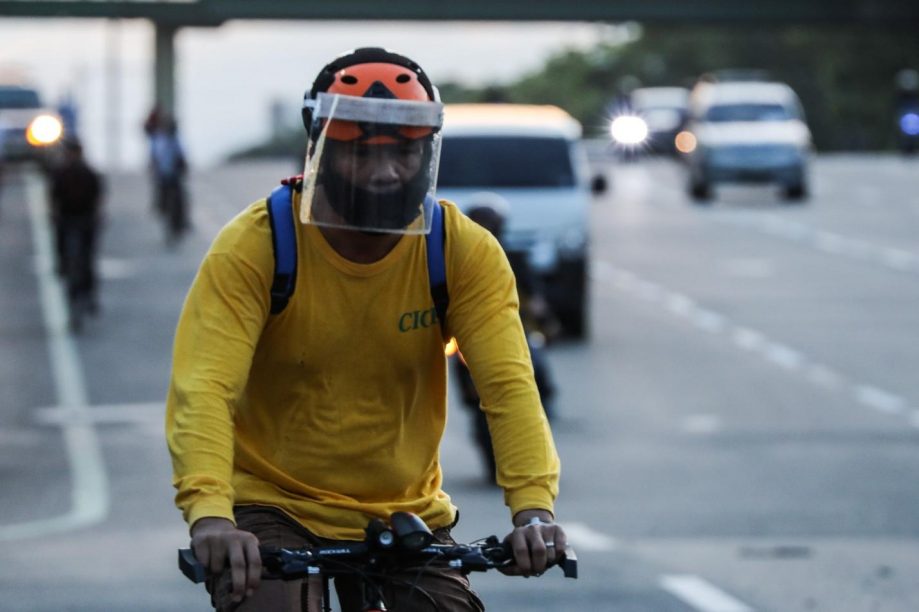 Biker wears a face shield attached to his helmet (Photo by Jire Carreon)
Biker wears a face shield attached to his helmet (Photo by Jire Carreon)
Hitting the road
In 2010, the World Bank noted an increase in energy consumption from the Philippines’ transport division, making up about 37% of the country’s total energy consumption—most of it coming from road transportation.
But with the declaration of the Enhanced Community Quarantine (ECQ) two months ago, people were discouraged from leaving their homes and public transportation was banned, resulting in empty roads. With essential businesses such as hospitals, pharmacies and food markets continuing operations, employees and consumers who didn’t own cars rode bicycles or walked.
Danielle Guillen, an urban transport planner and professorial lecturer at the University of the Philippines Diliman’s School of Urban and Regional Planning and Asian Institute of Tourism, makes this observation: “I think the ECQ showed that active transport is doable in Metro Manila if there are few motorized vehicles on the road. The ECQ really brought back the road space for people. Active transport (biking and walking) is only doable if we have enough road spaces that are connected, safe, and green shared with pedestrians and cyclists. Aside from the hard infrastructure that includes people-friendly designs, the soft infrastructure should be there. This means building the culture where motorists respect pedestrians and cyclists like what we see in most developed countries. This would mean embedding prioritizing transport ethics in our educational and motor vehicle registration systems.”
 Bike and pedestrian paths in Tsukuba, Japan (photo by Caryn Santillan)
Bike and pedestrian paths in Tsukuba, Japan (photo by Caryn Santillan)
 Parked bikes in Amsterdam, Netherlands (photo by Johan Marten)
Parked bikes in Amsterdam, Netherlands (photo by Johan Marten)
How other countries do it
During the quarantine, biking and walking for most people was a novelty. But in other countries, such forms of active transport have always been the norm.
Caryn, who lived in Japan for more than a decade, shares that Tokyo train stations provide overnight parking lots for bicycles so employees could bike from the station to their offices in the morning. “Active transport is very much integrated into their way of life. Very early on, kids are taught to walk to school. They were allowed to use a bicycle to commute when they were old enough. Some bicycles are fitted with attachments for transporting one to two preschoolers, or have baskets for groceries. The bikes have safety features, and need to be registered at the local ward office.”
For seven years, Aloy lived in the Netherlands, where active transport is the default lifestyle with children learning to bike as early as two years old. “Some families even have different kinds of bikes—the everyday, inexpensive one for daily trips to work, errands or visiting friends; and the fancier, sturdier bikes for long-distance weekend trips. There are cargo bikes for carrying your little ones, and e-bikes for older members whose knees are getting weaker.” Because of this, rush hour in the Netherlands looks a lot different from Manila’s carmageddon. “Rush hour in the Netherlands is a swarm of bikes. Bike infrastructure is everywhere. In any party or gathering, I’m guessing that more than 80% of the people came in bikes.”
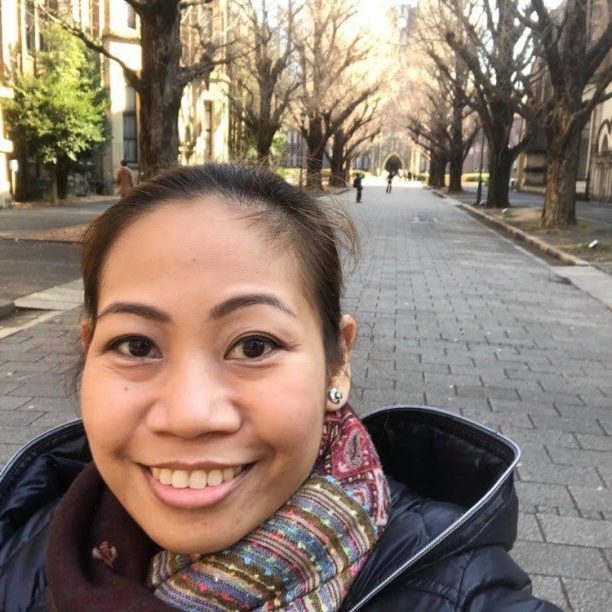 Caryn in Tokyo, Japan
Caryn in Tokyo, Japan
But in both Japan and the Netherlands, bikes are not the only kings of the road. In Japan, non-bikers like Caryn find it a breeze to walk. “Since most sidewalks are wide and clean, walking in Tokyo wasn’t a hardship—even in heels! When we moved to Tsukuba, which is about an hour away from Tokyo on the express train, I usually walked. It takes around 20 minutes for me and my kids to walk to the city center, but the pedestrian and bike paths are clean and very picturesque.”
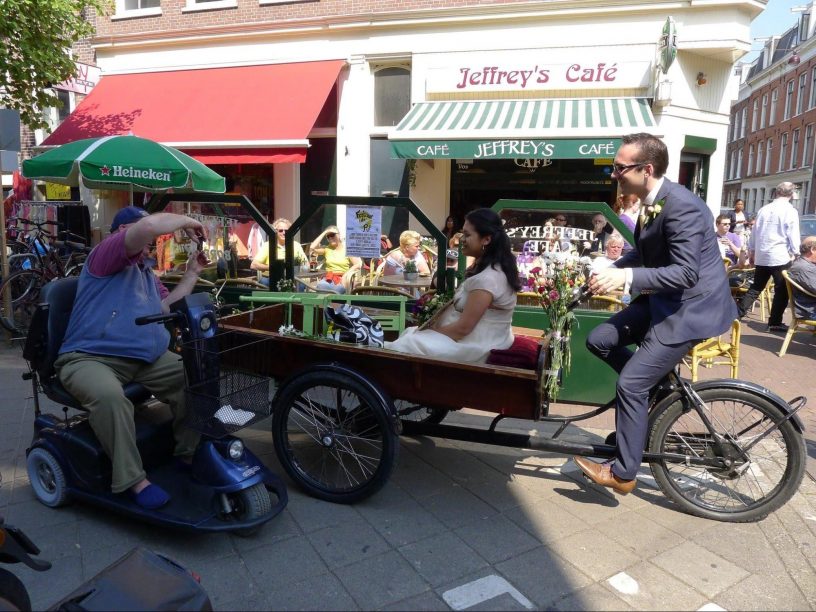 Aloy and Bram rode a cargo bike during their 2011 wedding in Netherlands
Aloy and Bram rode a cargo bike during their 2011 wedding in Netherlands
Aloy shares how the Dutch view walking, not just a means to get somewhere, but also a leisurely social activity. “It helps that there are so many parks. I feel that Dutch cities disincentivize car ownership by keeping roads small, maintaining high taxes on cars, taxis and parking fees, and maintaining bike paths with real barriers and bike stoplights.”
Aside from enabling Filipinos to easily clock in the recommended daily ten thousand steps to maintain good health, active transport also allows commuters greater mobility amid the pandemic. “It is the only means for us to really practice social distancing,” Guillen shares. “Walking is the very first mode of mobility that we could really control. Next is cycling, considered an advanced form of walking. If we have a really good walkway or cycling path infrastructure and space, we can easily estimate if we are two meters away from the others.”
Beyond walking and cycling
Aside from active transport, Guillen acknowledges the need for community public transportation that’s both safe and eco-friendly during the pandemic. “Other forms of public transportation would be busses and trains—as long as the social distancing and related health protocols are enforced. For short-distance trips, single-passenger pedicabs and tricycles are an option. However, it is important to note that the old jeepney does not really meet the public transport utility vehicle design standards. The government’s PUV(Public Utility Vehicle) modernization goal, if I understood it correctly, is to really update in terms of design and make the service meet service-level standards. With the pandemic, design and service should now consider social distancing and related health protocols.”
Even beyond the pandemic, Caryn wishes that the Philippine public transport will be a great equalizer like in Japan. “Train passengers are a mix of teenagers, suited businessmen, mommies pushing baby strollers, kimono-clad old ladies, and women in formal evening wear and fur coats,” recalls Caryn. “There are facilities for the disabled—elevators for wheelchairs, tactile paving, braille signs, and audio announcements (in different languages) for the visually impaired. And I greatly admire the pride instilled in their public transport employees. They all know they are part of an important system that helps the city run. They do their job competently and treat passengers respectfully.”
Aloy describes the Netherlands’ public transport system as a “well-oiled machine. When it falls out of schedule with a delayed train, you can hear the deep, deep disappointment rumbling through the crowd, because they are so used to efficiency. I was once on a train where the conductor apologized over the public system that we were arriving five minutes early at the destination.”
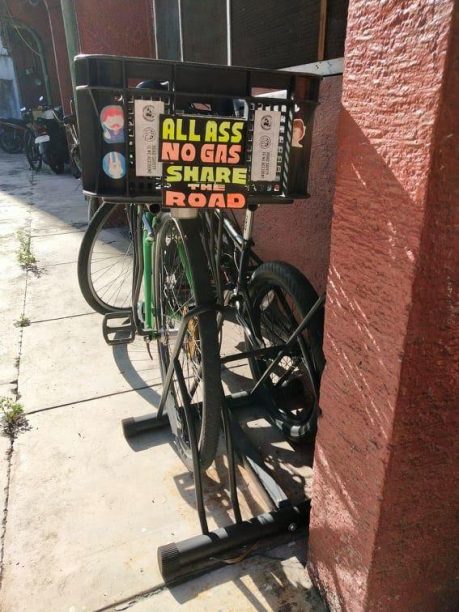 Bike placards (photo by Agay Llanera)
Bike placards (photo by Agay Llanera)
Wishlist for Manila’s public transportation
There is no doubt that the surge of private vehicles in Manila’s roads compound traffic. But why are urban Filipinos so car-centric? Guillen explains, “I think this a product of our long history where building highways was prioritized over the rails, as well as the culture that somehow equate car with economic development. Advertisements to market new vehicles could also play a role. Moreover, there is also the sad reality that public transport and options for active mobility are quite limited. To improve the existing public transport system, there should be enough supply during peak hours and off-peak hours. The system should also consider the active transport component of the whole mobility experience.”
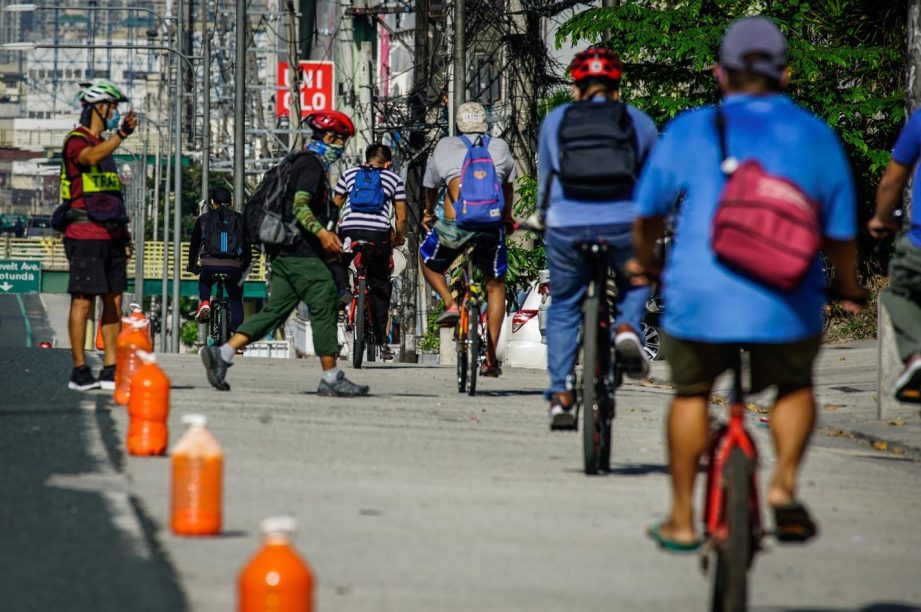 A volunteer assisting bikers during the pandemic (Photo by Jire Carreon)
A volunteer assisting bikers during the pandemic (Photo by Jire Carreon)
Aside from proper bus stops that are strictly followed, Caryn hopes for more waiting areas for commuters, including persons with disabilities (PWDs). “Imagine waiting for a bus under the midday heat or while it’s raining! Also, now that more people are using bicycles, bicycle theft has become a big issue. Establishments should provide secure parking racks— and wider, safer, well-lit sidewalks please, with no vendors taking up the space where people ought to pass. Most of all, I wish we would follow through with urban transport plans despite the changes in administration.”
Aloy wishes for a public transport system that allows commuters to enjoy their travel. “I try to imagine what commuting looks like to a 3-year-old— all 95 centimeters— and it must be frightening. As sociable as we Filipinos are, living in Metro Manila has not made it easy to meet up with friends. If I wanted to enjoy an after-work dinner with a small circle of friends, very few would agree to make it. The city and its transport system simply don’t allow for those connections to be nurtured.”
For Guillen, a country’s public transport system reflects the values of its government and its people. “A country with an exemplary public transportation system means it is a country that truly cares, prioritizing people’s inclusive mobility in the overall system. It is a truly democratic country that provides options to its people on choosing one that truly meets the environment, climate change, and health concerns.”
The country remains storms-free as the new week sets in.
According to PAGASA Weather Forecaster Samuel Duran, no weather disturbance is expected in the next three days.
Today, Ridge of a High Pressure Area extends over Northern Luzon, while Easterlies affect the rest of the country. These will bring partly cloudy to cloudy skies or a generally fair weather will prevail in the entire country only with chances of isolated rain showers or localized thunderstorms in the latter part of the day.
Warm Wednesday and Monsoon Break
In the midst of the Rainy Season, generally fair and warm weather is expected with the presence of the Ridge of a High Pressure Area (HPA) today.
“Ridge” refers to the extended part of an HPA or an anticyclone. Unlike a Low Pressure Area, this indicates an area where the atmospheric pressure is higher than its surroundings. Formation of clouds is usually suppressed, thus, less chance of rains. As it extends across Luzon, partly cloudy to cloudy skies will prevail in Metro Manila and the rest of the country only with isolated rain showers or thunderstorms.
In an interview with PanahonTV, PAGASA Weather Forecaster Robert Badrina said that the country is on a monsoon break.
Badrina also said that the country will experience a storm-free week.
Frontal system and Habagat bring rains to Luzon
Rains will prevail in most parts of Luzon on the last Sunday of May 2017.
According to PAGASA, the Frontal System is affecting the extreme Northern Luzon, while the Southwest Monsoon dominates the western section of Northern and Central Luzon. Frontal System refers to the boundary of two different air masses. Once this weather system becomes dominant in an area, it will generate convective clouds which will bring thunderstorms. Southwest Monsoon is defined as warm and moist winds moving in a southwest direction. Due to these characteristics, Habagat can cause monsoon rains that can last for a couple of days or even a week

As these weather systems prevail today, Ilocos Region, Cordillera and Batanes will experience moderate to occasionally heavy rains and thunderstorms. Residents of these areas are alerted against flash floods and landslides. In Central Luzon and the rest of Cagayan Valley, light to moderate rains and thunderstorms will be experienced. For the rest of Luzon, down to Visayas and Mindanao, partly cloudy to cloudy skies will prevail, only with isolated rain showers or thunderstorms.
While the present Habagat is categorized as weak, this, along with the Frontal System, has brought significant rainfall to some areas in Luzon. According to PAGASA Weather Forecaster Gener Quitlong, last week’s top three highest rainfall were recorded in these areas;
Batanes – 232 millimeters (mm) of rain in 24 hours – May 26, 2017
Calapan – 75.2 mm of rain in 24 hours – May 25, 2017
Casiguran – 76.2 mm of rain in 24 hours – May 24, 2017
This weekend, remember to bring your umbrellas as you make your “huling hirit sa tag-init,” because the prevailing Southwest Monsoon or Habagat brings possibilities of rains. According to PAGASA Weather Forecaster Loriedin dela Cruz, the habagat is in effect in the western section of Luzon and Visayas.
With its warm and moist characteristics, the habagat will bring cloudy skies with light to moderate rain showers and thunderstorms to the regions of Ilocos, Cordillera, MIMAROPA, CALABARZON, Bicol, Western Visayas and the provinces of Batanes, Cagayan, Zambales and Bataan. In the remaining parts of the country including Metro Manila, partly cloudy to cloudy skies prevails only with isolated rain showers or thunderstorms.
Photo courtesy of Nelson M. Velasco, Daraga, Albay
Dela Cruz adds that no weather disturbance is expected to affect the country in the next two days.
Generally fair weather prevails today. According to PAGASA Weather Forecaster Chris Perez, partly cloudy to cloudy skies will affect the archipelago only with isolated rain showers or thunderstorms mostly in the afternoon or evening as Easterlies, or warm and humid air from the Pacific Ocean, dominates.
Perez said, warm and humid weather is still expected today and heat index can soar up to 39.6 degrees Celsius.
If this good weather continues, we can enjoy various festivals this month.
In the Philippines, each city or municipality has a local festival of its own. The celebration includes the feast of the town’s patron saint, as well as an abundance of local products. Some of the festivals celebrated in May are the Bawang Festival of Ilocos province, the Hundred Islands Festival in Pangasinan, the Pahiyas Festival in Quezon, and the Flores de Mayo in almost every town.
Photo from PanahonTV Live Producer Paul Michael Caisip
A new weather disturbance is forecast to enter the Philippine Area of Responsibility (PAR) this week.
According to PAGASA, the Low Pressure Area (LPA) previously spotted outside PAR has developed into a tropical depression. As of 10 AM, it was located 1,540 kilometers east of Mindanao. It has maximum sustained winds of 45 kph and gustiness of 60 kph, slowly moving at a west-northwest direction.
According to PAGASA Weather Forecaster Loriedin dela Cruz, the LPA can possibly enter PAR within 24 hours. If this happens, the tropical depression will be given the local name “Dante,” this month’s second tropical cyclone.
Today, Easterlies or warm and humid air from the Pacific Ocean prevail in the eastern sections of the country. This weather system will bring partly cloudy to cloudy skies or generally fair weather in the entire archipelago except for isolated rain showers or thunderstorms. Humid weather is still expected to prevail.
Have you been complaining about the humid weather these past days? Well, the surge of the Northeast Monsoon may give you a break.
Yesterday, PAGASA recorded an air temperature of 36.5°C in Sinait, Ilocos Sur. With the humid weather, heat indices also continue to increase. Heat index refers to temperature obtained from the high air temperature and relative humidity. It also describes how the human body perceives the heat or the warm weather.
PAGASA Weather Forecaster Chris Perez reminded the public through an interview with Panahon TV that when the computed heat index value is between 30-40°Celsius, a person may experience exhaustion and stroke.
However, Amihan has slightly intensified today and is now affecting Northern and Central Luzon. This Tuesday, cloudy skies with light to moderate rains and isolated thunderstorms will prevail in the regions of Caraga and Davao. Cloudy skies with isolated light rains are also expected in the regions of Cagayan Valley and Cordillera, and the provinces of Aurora and Quezon. Partly cloudy to cloudy skies with isolated light rains will be experienced in the Ilocos Region and the rest of Central Luzon. Partly cloudy to cloudy skies with isolated rain showers or thunderstorms will prevail in Metro Manila and the rest of the country.
Strong to gale force winds associated with the surge of the Amihan are causing rough to very rough seas in the seaboards below. Fishing boats and other small seacraft are advised not to venture out while larger sea vessels are alerted against big waves.








